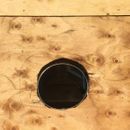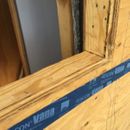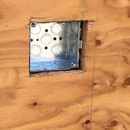A few air-sealing questions (at the sheathing stage).
Hello,
My plywood sheathing with be my exterior air barrier and my housewrap will not be (not taping the bottom of the wrap).
I have a few questions for some tips and advice for you. The question number corresponds with the picture number
1) What is the best way to airseal my outdoor panel box here in this picture?
2) The cutout around my bathroom exhaust fan has a lot of room around it. Will it be sufficient to just tape around or should I stuff some sort of insulation in the gap first?
3) Should I tape around my windows (before housewrap) since the housewrap will not be an air barrier?
Thanks!
GBA Detail Library
A collection of one thousand construction details organized by climate and house part












Replies
Tommy,
You may want to look at this link as well as listening to the advice you get here.
https://hammerandhand.com/best-practices/manual/
1. The first thing i'd do is replace any boxes that penetrate your plywood with air-tight ones. they have a gasket and many less holes. If you want to leave what's there, cover the box with a peel & stick membrane and foam the joint between the plywood and box.
2. A carefully cut piece of peel & stick membrane on the exterior (integrated with your house wrap) and spray foam on the interior would be my pick.
3. Flash the rough opening including a sill pan of whatever type you prefer. Install the window in a bed of caulking. Tape the exterior, foam and caulk the interior.
For #1, you need an air tight electrical box. But it would be interesting to know if these air seal well enough (when closed).
Malcolm - Awesome guide. I'm going to read over this more!
2) Sounds good. Is it common for the sleeve to be flush or slightly inside the exterior wall? I was imagining that the sleeve would come out past the wall.
3) Ok, just to clarify do you mean before the house-wrap stage? So basically, there would be tape over the window cutouts before house-wrap and then the house-wrap will be flashed afterwords as well? Redundant- I know. But just seems like it's necessary if I am counting on the sheathing to be my exterior air barrier.
Jon- what makes these airtight? Is there just an exterior flange that goes over the sheathing to then tape? Where is the best place to buy these?
One last question I have is air-sealing electrical wires. What is the best practice how to do so (see picture)? Would it be best to put a rubber grommet around each wire or should I just caulk/spray foam around this hole? I would like to be able to use tape but would be difficult without some sort of casing.
That outdoor cover plate has gaskets on the flip covers and has a gasket behind the plate. Not clear that this isn't negated with leaks between the siding and the sheathing.
IMO, good tape is much more effective than canned spray foam.
Tommy,
Hammer and Hand deserve a lot of respect for publishing all their hard-earned knowledge for everyone to use.
1. The way you have it is fine. As long as it doesn't protrude past the siding or block you are mounting it to.
2. Yes. As your plywood is your air-barrier you want to air-seal the window to the opening, not the house wrap. First goes a 12" strip of house wrap below the rough opening. I typically make a sill pan from peel & stick membrane, cover the the jambs and head with flashing tape then install the window as I described. The house wrap goes on last and is cut back to the flange around the opening so you end up with 1 1/4" for the last layer of flashing tape to adhere to. The house wrap is also cut below the window on both sides so you can pull a strip below the window through and have the correct lap.
Here is a video showing a similar sequence. The difference being I use flashing tape on the jamb and head first - and for some reason they don't use any metal flashing at the head.
https://www.youtube.com/watch?v=SqP4liutJFs
3. I'd use a fairly flexible caulking like Big Stretch. Make sure there is a staple on the framing inside to limit movement.
Great thank you. Big stretch looks like a good product. I'll use that for any caulking around electrical boxes if I don't get airtight ones.
Jon- I agree about the tape. I love using the tescon vana I have. But when an electrical box is inside of the sheathing (as my picture) it's very difficult to use tape for this application.
Considering I already have regular electrical boxes all wired, do you think I could get away with folding the tape over inside the boxes. Not sure if there are any hazards with that with the plugin. I suppose I could push in my vapor retarder a bit and tape to the sides of the electrical box.
DIYer here:
I'm curious. Why recess that 4" square box for outdoor power? I thought code (I am not an electrician) allowed romex out a drilled hole in the sheathing into the back of an exterior weatherproof box. And I thought code required a weatherproof cover (unless covered by porch etc) . Are you going to be able to find weatherproof covers for that 4" square? If not, are you mounting a weatherproof box on top of it? Do they even make those in 4" square? Maybe it has an application I'm not imagining ...
So basically, (again, I'm a DIYer and not an electrician so this advice is worth what you paid ...), I would not have cut a 4" square in the plywood and would have instead stubbed the wire out a ~1/2" hole. A tape gasket or spray foam or maybe caulk fills the gap around the wire in the plywood. Then mount an outdoor weatherproof box either on the sheathing or siding. (Which is better probably depends on your siding and exterior insulation choices)
If you do mount the outdoor box onto the sheathing directly, then you can apply a circle of caulk around the knockout you are using between the outdoor box and the plywood. as a second layer of protection against penetration or caulk around the edge of the box (added bonus of weather protection).
As for what you have there (the 4" metal box through the sheathing), my best understanding of the electrical code is that you can't use that box in that location. Perhaps others professionally qualified could provide a more definitive answer.
Keith,
I can't comment on your codes, but it meets Canadian ones and is how it is most commonly done here. Looking at the photo again, the only violation might be that it is recessed to the sheathing plane, and when siding was applied might need a box extender. Our lumberyards sell PVC and cedar blocks with cutouts for both single and double boxes to mount on the sheathing, which make flashing easier. There also sell double gasketted covers.
Having said all that, from an air and water sealing point off view I agree a weather- proof retro box works better. They just look really bad.
Hey Keith,
That is just how my electrician did it. Do you have a picture of what a recessed version would look like? I don't think this can be done with a cutout square already right?
Malcolm- Do you have a good source where I can buy airtight electrical boxes with flanges, as well as mud rings?
Also, if I do choose not to replace the electrical boxes with flanged ones, have you ever seen tape sealing done with regular electrical boxes? I was thinking of either 1) wrapping the tape slightly into the electrical box or 2) taping the sides of the electrical box to my vapor retarder. Both would accomplish air-tightness, just not near as convenient as flanged boxes. For option number 1, my electrician said this would be ok and would not be a hazard but still curious what you guys opinion is on that? Also, would it make sense to seal (tape) after the mud ring is installed or before?
http://airfoilinc.com/products/products.html
Malcolm - quick question. You mentioned big stretch around electric wires. I see that it is water based. Is it ok to use water based caulk on electric wires?
Grey Wolf,
It doesn't adhere to the wires, but to me that's a good thing. It in effect forms a caulk gasket around them.
Cool, yea I was just wondering if it was considered a fire hazard using anything besides fire rated caulk. I assume the high performance tapes are ok to use too?
fire rated caulking and tape are for situations where the penetrations are in a fire-rated assembly. You are using caulking as an air barrier. You are fine.